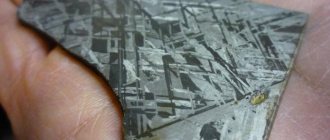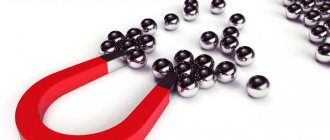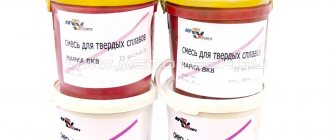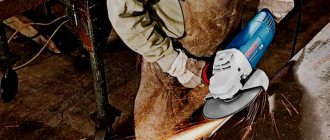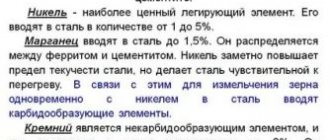Use in its pure form
Nickel is a silver-colored metal. It has high strength and ductility. It has ferromagnetic properties, is well welded, forged and stamped. Resistant to acids and alkalis. Will not oxidize in open air due to the oxide film.
Areas of application of the material in its pure form:
- Used as a protective coating for other metal surfaces. In this case, the protective layer is applied using cladding or galvanoplasty methods. Protects other metals from corrosive processes.
- Containers for storing and transporting chemicals, acids, and alkalis are made of metal.
- It is often used as a catalyst. This is due to the catalytic properties of the material, which are similar to palladium. However, this metal is much cheaper.
- Manufacturing of neutron beam choppers. Thanks to this, the metal became widespread in nuclear physics.
In addition to its use in the food and chemical industries, the pure material is used in the manufacture of alkaline batteries.
NICKEL, NICKEL AND COPPER-NICKEL ALLOYS, PRESSURE TREATED
Stamps
Official publication
Moscow
Standardinform
2011
Preface
The goals, basic principles and basic procedure for carrying out work on interstate standardization are established by GOST 1.0-92 “Interstate standardization system. Basic provisions" and GOST 1.2-97* "Interstate standardization system. Standards
interstate, rules and recommendations for interstate standardization. Procedure for development, adoption, application, updating and cancellation"
Standard information
1 DEVELOPED by the Technical Committee for Standardization TC 106 "Tsvetmetprokat", Research, Design and Engineering Institute of Alloys and Processing of Non-Ferrous Metals "Open Joint Stock Company "Institute Tsvetmetobrabotka" (JSC "Institute Tsvetmetobrabotka")
2 INTRODUCED by the Technical Secretariat of the Interstate Council for Standardization, Metrology and Certification
3 ADOPTED by the Interstate Council for Standardization, Metrology and Certification (Protocol No. 29 of June 24, 2006)
The following voted for the adoption of the standard:
| Short name of the country according to MK (ISO 3166) 004—97 | Code of the country according to MK (ISO 3166) 004-97 | Abbreviated name of the national standardization body |
| Azerbaijan | AZ | Azstandard |
| Armenia | A.M. | Ministry of Trade and Economic Development |
| Belarus | BY | State Standard of the Republic of Belarus |
| Kazakhstan | KZ | Gosstandart of the Republic of Kazakhstan |
| Kyrgyzstan | KG | Kyrgyzstandard |
| Moldova | M.D. | Moldova-Standard |
| Russian Federation | RU | Federal Agency for Technical Regulation |
| knowledge and metrology | ||
| Tajikistan | T.J. | Tajikstandard |
| Uzbekistan | UZ | Uzstandard |
| Ukraine | U.A. | Gospotrebstandart of Ukraine |
4 By Order of the Federal Agency for Technical Regulation and Metrology dated December 27, 2006 No. 498-st, the interstate standard GOST 492-2006 was put into effect as the national standard of the Russian Federation on January 1, 2008.
5 INSTEAD GOST 492-73
6 REPUBLICATION. June 2011
Information on the entry into force (termination) of this standard is published in the “National Standards” index.
Information about changes to this standard is published in the “National Standards” index, and the text of the changes is published in the “National Standards” information indexes. In case of revision or cancellation of this standard, the relevant information will be published in the information index “National Standards”
* On May 1, 2010, GOST 1.2-2009 came into force.
© Standartinform, 2007 © STANDARDINFORM, 2011
In the Russian Federation, this standard cannot be fully or partially reproduced, replicated and distributed as an official publication without permission from the Federal Agency for Technical Regulation and Metrology
INTERSTATE STANDARD
NICKEL, NICKEL AND COPPER-NICKEL ALLOYS, PRESSURE TREATED
Peculiarities
Nickel and alloys based on it have certain features and characteristics. It is important to consider them before using them in industry.
Structure and composition
The structure of nickel-based alloys varies depending on what components are included in their composition. The characteristics of the finished material also depend on this. This material is a silver-colored metal found in the earth's crust, water and air. In nature you can find not only a homogeneous metal, but also mixtures based on it. This is due to the fact that it combines well with other materials. Common components in mixtures are iron, molybdenum, copper, chromium.
Properties and characteristics
The physical and chemical properties of a material help determine where it can be used and how it will change during certain processing steps. Characteristics:
- Density - 8800 kg/m3.
- Melting point - 1455 degrees Celsius.
- Boiling point is about 2900 degrees.
- Maximum tensile strength - 9000 MPa.
- Thermal conductivity - 90.9 W/(m*K).
- Electrical resistance - 0.0684 μOhm*m.
Due to their characteristics, nickel and mixtures based on it are used in various areas of industry. They lend themselves well to processing on industrial equipment, which expands their scope of application.
Stamps
According to the state document GOST 849-2008, 7 grades of nickel are designated. These include H0, H1,2,3,4, H1Ay and H1y. The composition of the brands is the content of the main substance up to 99.9%, a small amount of cobalt and third-party impurities.
Alloys
Nickel is the basis of many alloys. It is worth taking a closer look at the most popular compounds based on this metal.
With copper
The most popular compounds are nickel and copper. The result is a material that is not similar in its characteristics to the original metal. In the manufacture of metal mixtures, 3 popular compounds can be distinguished:
- Monel is a material that contains approximately 67% nickel. Has a high strength index. It can be compared with different types of steels. Used in aircraft manufacturing, shipbuilding, and in the manufacture of power tools. You can find monel parts in musical instruments.
- Cupronickel is a well-known alloy whose main component is copper. Nickel in the composition can contain up to 30%. Used in the manufacture of jewelry, figurines, cutlery.
- Copel is a mixture of 44% nickel. The wire from which compensation wires are made is made from it.
There are other mixtures with the addition of zinc, which have their own characteristics and characteristics.
With chrome
Compounds of chromium and nickel are known to many as nichrome. The peculiarity of this alloy is its high electrical resistance and high melting point. Nichrome also has good strength and heat capacity. Applications:
- Manufacturing of parts for devices operating in aggressive environmental conditions.
- Production of heating elements and equipment for heat treatment.
- Nichrome wire is used in the manufacture of electric furnaces.
- This alloy is used to make evaporation filaments used in electronic cigarettes.
If nichrome is coated with a silicon-based alloying layer, it can be used in the chemical industry. The additional coating makes the material resistant to acids.
With molybdenum and other metals
When combining nickel with molybdenum, chromium is added to the composition. The percentage of base metal reaches 77%. In this case, molybdenum in the composition can contain up to 9%. The rest is occupied by chromium. The peculiarity of the connection is its high strength and rigidity.
An alloy with molybdenum is used in medicine. Bridges are made from it. Difficult to process. It is almost impossible to make castings from such material. However, due to their characteristics and low cost, alloys with molybdenum are highly popular.
With iron
This mixture is called invar. It is a compound of iron and nickel. They use ready-made material in the manufacture of parts for mechanical watches.
Nickel and alloys based on it, marking, properties and scope of application
Nickel
– the metal is silver-white in color with a yellowish tint, melts at a temperature of 1455 °C, has a density of 8.91 g/cm3;
hard, highly polished, ferromagnetic ( ТкNi
= 358 оС), has high corrosion resistance - stable in air, water, alkalis and a number of acids. In its pure form, nickel is almost never used; the bulk of it is used for the production of various alloys with iron, copper, zinc and other metals. About 20% of global nickel production is spent on producing electroplating*.
Nickel-based alloys can be divided into heat-resistant, heat-resistant, magnetic and alloys with special physical properties**.
Heat-resistant and heat-resistant nickel-based alloys are used for the manufacture of parts operating at temperatures of 700...1100 oC.
Heat-resistant deformable (KhN77TYUR, KhN70VMTYu, KhN55VMTFKYu) and cast (ZhS6K) superalloys
, intended for the manufacture of working blades and disks of gas turbines, as well as various elements of rocket engines, are obtained by alloying nickel with chromium, titanium, aluminum, tungsten, molybdenum and other elements. The best performance properties of parts made from these alloys are achieved by hardening and subsequent aging.
Heat-resistant alloys – nichrome
(Х20Н80, Х20Н75БТУ, Х25Н60В15Т) have high electrical resistivity, have good technological properties - they are easily deformed and welded, and are widely used for the manufacture of heating elements for various electric ovens and household appliances, as well as parts operated at high temperatures.
Many nickel alloys have special names, for example, alloy NMZhMTs28-2.5-1.5 (28% Cu
, 2.5%
Fe
, 1.5%
Mn
) is called
Monel metal
, which is widely used for the manufacture of corrosion-resistant parts for various industries (pickling tanks, steam boiler fittings, etc.).
The cost of nickel alloys is approximately 100 times higher than the cost of ordinary steel.
53(38). Refractory metals and alloys, markings, properties and scope of application
The following refractory metals are most widely used in technology: Cr
(1875),
Nb
(2468),
Mo
(2625),
Ta
(2994) and
W
(3410)[52]. These metals are widely used to improve the heat resistance of alloy steels and cast irons. Niobium-based alloys are indispensable in nuclear technology due to their resistance to neutron irradiation. Molybdenum and tungsten in their pure form are used in chemical engineering, glass industry, radio electronics, lighting engineering, etc. In particular, heating elements of high-temperature furnaces, filaments of lighting and electronic lamps, contacts of high-current relays, etc. are made from tungsten, the most refractory metal.
All refractory metals have low heat resistance in the presence of oxygen, so at temperatures above 400...600 oC they must be protected from oxidation in air. To do this, use vacuum, inert gases, nitrogen, hydrogen, as well as special coatings, for example, molybdenum and tungsten disilicide ( MoSi
2
,WSi
2).
The heat resistance of pure metals is relatively low. Their alloys based on niobium (VN2, VN2A, VN3, VN4), molybdenum (TsM2A, TsM3, TsM6, VM2, VM3) and tungsten (VV2) have higher heat resistance. When creating such alloys, alloying with rhenium, lanthanum and thorium oxides, hafnium carbide, etc. is widely used.
pseudo-alloys are becoming increasingly common
, consisting of mutually insoluble components:
W – Ag
,
W – Cu
,
W – Ni – Cu
.
To obtain these materials, a porous frame pre-sintered from tungsten powder is impregnated at high temperature with the liquid metal component of the composition. Pseudo-alloys are used to make nozzle liners for rocket engines, contacts for high-voltage switches, electrodes for resistance welding machines, nozzles and interelectrode inserts for plasma torches. When heating a pseudo-alloy product, its temperature cannot rise above the boiling point of the low-melting component ( t
bale
Ag
= 2167 °C,
t
bale
Cu
= 2543 °C) as long as the pores contain liquid metal.
54(39). Antifriction materials, marking, structure, properties and scope of application
Antifriction materials are intended for use in various sliding friction bearings, which are used more often than rolling friction bearings (ball and roller). These materials must have a set of contradictory performance properties: a low coefficient of friction in relation to shafts, usually made of hardened steel; high wear resistance combined with low hardness so that the shaft does not wear out; sufficient strength and relatively easy to deform to take the shape of the shaft; corrosion resistance and high thermal conductivity to remove heat generated by friction; holds lubricant well on the surface, etc. Depending on the composition, antifriction materials are distinguished: metal (alloys), non-metal (polymer, graphite, wood, etc.) and combined (metal-polymer, graphite-metal, etc.)
Anti-friction alloys
of various compositions have found the widest application in industry for the manufacture of plain bearing shells. To ensure the required performance properties, the structure of antifriction alloys must consist of a soft and plastic base, in which solid particles of chemical compounds are embedded. In this case, the shaft, supported by solid particles, quickly wears into the bearing, and the resulting grooves from the movement of solid particles form microscopic channels through which lubricant circulates and wear products are carried away.
Rice. 54. Microstructure of tin babbitt
Babbitts have the highest anti-friction properties
[53] – soft alloys based on tin or cheaper lead.
Babbitts are applied in the form of a thin layer (up to 1 mm) on the surface of the sliding support. The most expensive Babbitt B88 contains 88% tin, antimony, copper and cadmium. The soft base in it is an α-solid solution of antimony in tin, and the hard particles are formed by the β-phase - a solid solution based on SnSb
and crystals of the chemical compound
Cu
3
Sn
- Fig.
54. Tin babbits are used for bearings of heavily loaded machines (turbines, electric generators, mining excavators, etc.). The cheaper lead-tin babbitt BS6 contains 6% tin, lead, antimony and copper. Even cheaper are lead-calcium babbits of the BKA, BK2 type, containing tenths of a percent of Ca
and some other elements.
The previously discussed copper-based alloys - brass and bronze (tin, aluminum, lead bronze and silicon and manganese brasses) have high anti-friction properties. In the most critical cases, bronzes with a high content of tin and lead are used.
Anti-friction cast irons
according to GOST 1585-85 (gray AChS-1, ... AChS-6, high-strength AChV-1, AChV-2 and malleable AChK-1, AChK-2) the range of performance properties is comparable to copper-based alloys. The antifriction properties of cast iron are largely determined by the structure of the graphite component, which acts as a solid lubricant. In the structure of antifriction cast iron, it is desirable to have larger inclusions of graphite, a minimum amount of free ferrite (up to 15%) and there should be no free cementite.
For less loaded structures, the following are used as bearing bushings:
— zinc antifriction alloys containing aluminum and copper: TsAM 9.5-1.5; TsAM 10-5 (10% Al
, 5%
Cu
, the rest
Zn
), replacing more expensive tin bronzes at temperatures up to 100 °C;
- aluminum antifriction (bearing) alloys containing tin, copper, nickel and silicon: AO3-1 (3% Sn
, 1%
Cu
, 0.4%
Ni
, 1.9%
Si
, the rest
Al
), AO9-2, AO20-1, AN-2.5 (2.5%
Ni
, the rest
Al
).
Currently, in lightly loaded bearings, the use of bushings made of polymer and composite materials, consisting of either a single polymer (nylon, fluoroplastic-4), or a polymer with filler (textolite), or a mixture of iron-graphite, bronze-graphite, metal fluoroplastic and etc. The use of sliding bearings made of self-lubricating plastics simplifies the design and reduces costs in the manufacture and operation of products.
Carbon-graphite antifriction materials
used for operation without additional lubrication in various gas and liquid aggressive media (acids, alkalis, salt solutions and organic solvents) in a wide temperature range from –200 to +2000 oC*.
Antifriction materials based on hardwood (buckout, boxwood, beech) and fluorocarbon rubber, intended for use in an aqueous environment that acts as a lubricant, have limited use.
Application area
Pure metal is not used as often as nickel alloys. Application areas of alloys:
- They are used in mechanical engineering, construction, and pipeline manufacturing. Massive structures are made from this metal and are protected from rust.
- Parts for equipment that operates in aggressive environments. The alloys are resistant to acids, corrosive processes, and alkalis.
- Alloys are used to make gas turbines.
- In everyday life, products made from nickel alloys can be found in the form of furniture fittings, taps and mixers.
- Nickel is part of the alloys that are used to make white gold.
Nickel-cadmium batteries are made from this material. Metal compounds are diverse and due to this they are used in various areas of industry.
